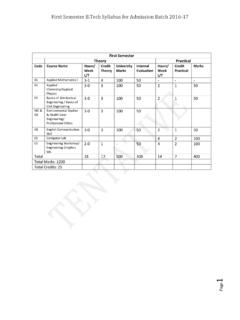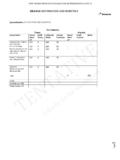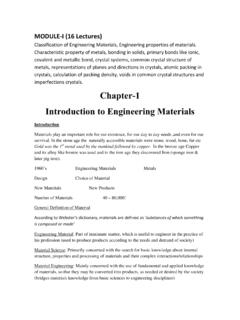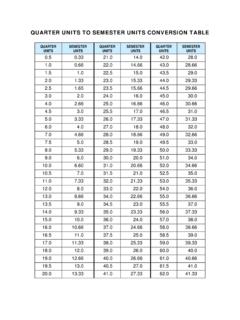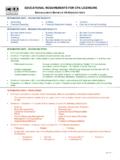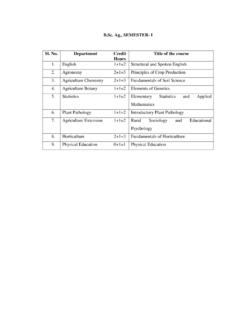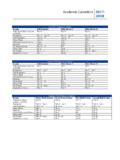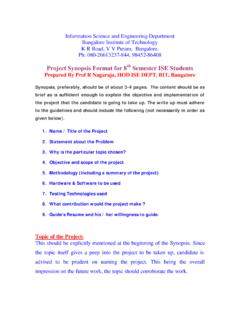Transcription of Second Semester Theory Practical Credit University ...
1 2nd Semester Syllabus for Admission Batch 2016-17. Second Semester Theory Practical Code Course Name Hours/ Credit University Internal Hours/ Credit Marks week Theory marks Evaluation Week Practical L/T L/T. BS Applied Mathematics-II 3-1 4 100 50 - - - BS Applied Physics/Applied 3-0 3 100 50 2 1 50. Chemistry ES Basics of Civil 3-0 3 100 50 2 1 50. Engineering / Basics of Mechanical Engineering MC & Environmental Studies 3-0 3 100 50. GS & Health Care Engineering/. Professional Ethics ES Electrical & Electronics 3 3 100 50 2 1 50. Engineering ES Computer Lab 4 2 100. ES Engineering Graphics 2-0 1 - 50 4 2 100. Engineering Workshop MC NSS/NCC/NSO/Yoga 2 1 50. Total 18 17 500 350 16 8 350. Total Marks: 1200. Total Credits: 25. 2nd Semester Syllabus for Admission Batch 2016-17. ES/MC -ELECTRICAL & ELECTRONICS ENGINEERING (3-1-0). Module I (10 Hours). University Portion (80%). Fundamentals of Electric Circuits: DC Circuits: Voltage and current sources (Ideal and Practical ), Charge, current, Kirchhoff's laws, circuit elements and their characteristics, Resistance and Ohm's Law, Measuring Devices (Ohm meter, Ammeter, Volt meter).
2 Node voltage analysis, Mesh current analysis, with controlled and uncontrolled sources, superposition, Thevenin's and maximum power transfer Theorem. AC Circuits: Energy storage elements, time dependent signal sources, solution of circuits containing energy storage elements, phasor solutions of the circuits with sinusoidal excitations, AC circuit analysis. Transient Analysis, Writing differential equations for circuits, Star-Delta Conversion. College/Institute Portion (20%). DC steady state solutions of circuits, Resonance in series and parallel R-L-C circuit, Time response of Second -order circuit OR any related topic as decided by the concerned faculty member teaching the subject. Module II (10 Hours). University Portion (80%). AC Power: Power in AC circuits, Complex Power, Three-phase power, three phase power measurement by 3 and 2 wattmeter methods, Generation and distribution of AC Power. Magnetic Circuits and Transformer: Electricity and Magnetism, Magnetic Circuits, Magnetic Materials and B-H curves, Single phase Transformers: Operating principle, emf equation and turns ratio.
3 Introduction to Machines: DC Machines, AC Machines College/Institute Portion (20%). Residential Wiring, Grounding and safety, Measurement Systems and Transducers, or any related topic as decided by the concerned faculty member teaching the subject. Module III (12 Hours). University Portion (80%). Semiconductor Diodes: Intrinsic semiconductors, Doped semiconductors, P-N junction with open circuit, P-N junction with an applied voltage, Ideal Diode, Terminal characteristics of junction diode, modeling the diode forward characteristics, Operation in the reverse breakdown region-Zener Diode, Rectifier circuit, special Diode. Bipolar Junction Transistors (BJTs): Simplified structure and physical operation of n-p-n and p-n-p transistors in the active region, Current-voltage characteristics of BJT, BJT as an amplifier and as a switch BJT Circuits at DC, Biasing in BJT amplifier circuits, Small Signal Operation of BJT: Simplified hybrid- model and its application to single stage BJT.
4 Amplifiers (Common-Emitter, Common-Base and Common-Collector configurations). College/Institute Portion (20%). The Operational Amplifier (Op-Amp): The ideal Op-Amp, Inverting and non-inverting configurations, Difference amplifier, CMRR, Application of Op-Amp (Instrumentation amplifier, Summing amplifier, Integrator and Differentiator) OR any related topic as decided by the concerned faculty member teaching the subject. 2nd Semester Syllabus for Admission Batch 2016-17. Module IV (10 Hours). University Portion (80%). Digital Electronic Principles: Introduction, Binary digits, Logic levels and Digital waveforms, Introduction to basic Logic operation, Number system, Decimal numbers, Binary numbers, Decimal-to-Binary conversion, Simple binary arithmetic. Logic Gates, Boolean algebra and Combinational Logic Circuits: The inverter, The AND, OR, NAND NOR, Exclusive-OR and Exclusive-NOR gate, Boolean operations and expressions, Laws and Rules of Boolean algebra, DeMorgan's theorem, Boolean analysis of logic circuits, Standard forms of Boolean expressions, Boolean expression and truth table.
5 Basic combinational logic circuits, Implementation of combinational logic, the universal properties of NAND and NOR gates, Basic adders. College/Institute Portion (20%). Multiplexers and Demultiplexers. OR any related topic as decided by the concerned faculty member teaching the subject. Text Book 1. Foundations of Electrical Engineering, Leonard , Oxford University Press, Asian Edition published in 2013. 2. Edward Hughes (revised by Ian McKenzie Smith), Electrical & Electronics Technology , Pearson Education Limited. Indian Reprint 2002, 10th Edition REFERENCE BOOKS. 1. Principles and Applications of Electrical Engg., Rizzoni, McGrawHill. 2. , Advanced Electrical Technology", CBS Publishers, New Delhi, 7th Edition 3. Electronic Instrumentation, Kalsi, Tata McGraw-Hill Publishing Company Limited, New Delhi. 4. Microelectronic Circuits (sixth Edition), Adel S. Sedra and Kenneth C. Smith, Oxford University Press, 5. Digital Fundamentals (Eighth Edition), Thomas L.
6 Floyd and Jain, Pearson Education. 6. Basic Electrical and Electronics Engineering, D P Kothari, I J Nagrath, Mc Graw Hill Education (India) Private Limited, Copyright 2014. 7. Basic Electrical and Electronics Engineering, , ,Oxford, First published 2012. 2nd Semester Syllabus for Admission Batch 2016-17. ELECTRICAL & ELECTRONICS ENGG. LABORATORY. Group-I. 1. Familiarization of electronic components and devices (Testing of semiconductor diodes and transistors using digital multimeter). 2. Study and use of Oscilloscope, signal generator to view waveforms and measure amplitude and frequency of a given waveform. 3. V-I characteristics of semiconductor diode and determining its DC and AC. resistance. 4. Studies on half-wave and full-wave rectifier circuits without and with capacitor filter; recording of the waveforms and measurement of average and rms values of the rectifier output. 5. V-I characteristic of an n-p-n or p-n-p transistor, DC biasing the transistor in common-emitter configuration and determination of its operating point ( , various voltages and currents).
7 6. Studies on Logic gates (Truth table verification of various gates). Group-II. 1. Study of different electrical equipments. 2. Power factor improvement using capacitor for fluorescent lamp. 3. Verification of Superposition and Thevenin's theorem. 4. Polarity test of transformer. 5. Power measurement using 2-wattmeter method. 6. Calculation of current, voltage and power in series R-L-C circuit excited by single- phase AC supply and calculation of power factor. 2nd Semester Syllabus for Admission Batch 2016-17. APPLIED MATHEMATICS-II. Module - I (10 Hours). Laplace transformation and its use in getting solution to differential equations, Convolution, Integral Equations. Module - II (12 Hours). Fourier series, Fourier expansion of functions of any period, Even and odd functions, Half range Expansion , Fourier transform and Fourier Integral, Gamma, Beta functions, error function Module - III (10 Hours). Vector differential calculus: vector and scalar functions and fields, Derivatives, Curves, tangents and arc Length, gradient, divergence, curl Module - IV (13 Hours).
8 Vector integral calculus: Line Integrals, Green Theorem, Surface integrals, Gauss theorem and Stokes Theorem Text Book 1. Advanced Engineering Mathematics by E. Kreyszig, John Willey & Sons Inc. 10th Edition Chapters 6, 9, 10,11. Reference Books: 1. Higher Engineering Mathematics by B. V. Ramana , Mc Graw Hill Education 2. Engineering Mathematics by .Pal and s. Bhunia, Oxford Publication 3. Advance Engineering Mathematics by O'Neil, CENGAGE. 2nd Semester Syllabus for Admission Batch 2016-17. APPLIED PHYSICS. Module-I (07 Classes). Classical Dynamics Principle of virtual work, De-Alembert Principle, Action principle, Langrage equation of motion and its application to Simple Harmonic oscillator. Velocity dependent potential. Oscillation & Waves Simple Harmonic Oscillation, damped harmonic oscillation, Forced oscillator, resonance, coupled oscillation, concept of wave and wave equation. OPTICS. Concept of interference, two source interface pattern, Bi-prism, Michelson Interferometer &.
9 Measurement of wavelength. Diffraction: Hugen's principle, Fresenel & Frauhoper's diffraction, Zone plate. Module-II (07 Classes). Solid State Physics Crystalline and amorphous solid, unit cell, Miller Indices, Reciprocal lattice, Bragg's law, Brillouin's zone, concept of fermions, Maxwell-Boltzmann, Fermi-Dirac and Bose-Einstein distribution function (only statement and formula), Concept of Fermions and Bosons. Classification of materials: metals, semiconductor and insulator in terms of band Theory LASER and Fibre Optics: principle and application -stimulated emission, population inversion, Lasing material (solid and gas), He-Ne laser, Rubi- LASER, Application of LASER (Engineering Application), Principle of optical fibre and its application to communication. Module-III (08 Classes). Electromagnetism- Student will be familiarized with some basic used in vector calculus prior to development of Maxwell's electromagnetic wave equations. No proof of theorems and laws included in this unit expected- statement and interpretation should sufficient.
10 A) Vector calculus: gradient of scalar field, divergence, curl of vector field (Only Physical significance) Gauss divergence theorem, Stoke's theorem, Green's theorem (Only Statements). b) Gauss's law of electrostatics in free space and in a medium(Only statements)electric displacement( D)magnetic Induction (B),Amperes circuital law (Only statements), displacement current, Faraday's law of electromagnetic induction(Only statements). 2nd Semester Syllabus for Admission Batch 2016-17. Module-IV(08 Classes). Quantum Physics: Elementary concepts of quantum physics formulation to deal with physical systems. a) Need for Quantum physics-Historical overviews, Particle aspects of radiation-Black body radiation, photoelectric effect, Compton scattering, pair production.( No derivations), Wave aspect of particles- matter wave, de Broglie Hypothesis, Heisenberg Uncertainty principles- Statement, Interpretation and example b) Basic features of Quantum mechanics- Transition from deterministic to probabilistic, States of system- Wave function, probability density, superposition principle, observables and operators, expectation values.
